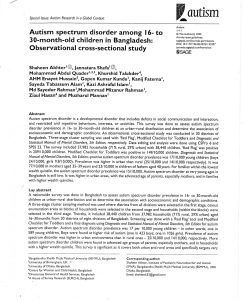New research article has been published in SAGE Journal by IPNA Director
Autism spectrum disorder among 16- to 30-month-old children in Bangladesh: Observational cross-sectional study
Abstract
Autism spectrum disorder is a developmental disorder that includes deficits in social communication and interaction, and restricted and repetitive behaviours, interests, or activities. This survey was done to assess autism spectrum disorder prevalence in 16- to 30-month-old children at an urban–rural distribution and determine the association of socioeconomic and demographic conditions. An observational cross-sectional study was conducted in 30 districts of Bangladesh. Three-stage cluster sampling was used with ‘Red Flag’, Modified Checklist for Toddlers and Diagnostic and Statistical Manual of Mental Disorders, 5th Edition, respectively. Data editing and analysis were done using CSPro 6 and SPSS 23. The survey included 37,982 households (71% rural, 29% urban) with 38,440 children. ‘Red Flag’ was positive in 209/10,000 children. Modified Checklist for Toddlers was positive in 149/10,000 children. Diagnostic and Statistical Manual of Mental Disorders, 5th Edition–positive autism spectrum disorder prevalence was 17/10,000 young children (boys 24/10,000, girls 9.8/10,000). Prevalence was higher in urban than rural (25/10,000 and 14/10,000 respectively). It was 77/10,000 in mothers aged 35–39 years and 23/10,000 in children of fathers aged 40 years. For families within the lowest wealth quintile, the autism spectrum disorder prevalence was 15/10,000. Autism spectrum disorder at very young ages in Bangladesh is still low. It was higher in urban areas, with the advanced age of parents, especially mothers, and in families with higher wealth quintiles.
Lay abstract
A nationwide survey was done in Bangladesh to assess autism spectrum disorder prevalence in 16- to 30-month-old children at urban–rural distribution and to determine the association with socioeconomic and demographic conditions. A three-stage cluster sampling method was used where districts from all divisions were selected in the first stage, census enumeration areas as blocks of households were selected in the second stage and households (within the blocks) were selected in the third stage. Thereby, it included 38,440 children from 37,982 households (71% rural, 29% urban) aged 16–30 months from 30 districts of eight divisions of Bangladesh. Screening was done with a ‘Red Flag’ tool and Modified Checklist for Toddlers and a final diagnosis using Diagnostic and Statistical Manual of Mental Disorders, 5th Edition for autism spectrum disorder. Autism spectrum disorder prevalence was 17 per 10,000 young children – in other words, one in 589 young children. Boys were found at higher risk of autism (one in 423 boys; one in 1026 girls). Prevalence of autism spectrum disorder was higher in urban environments than in rural ones – 25/10,000 and 14/10,000, respectively. More autism spectrum disorder children were found in advanced age groups of parents, especially mothers, and in households with a higher wealth quintile. This survey is significant as it covers both urban and rural areas and specifically targets very young children. The involvement of the Bangladesh Bureau of Statistics, as well as support from the entire healthcare system infrastructure, makes this survey more representative on a national level. Its results will form a database to support the development of an effective early intervention programme in Bangladesh. We hope it will prove useful for researchers, clinicians and frontline healthcare workers, and inform the decisions of policymakers and funders in Bangladesh.
Akhter, S., Shefa, J., Quader, M. A., Talukder, K., Hussain, A. E., Kundu, G. K., Fatema, K., Alam, S. T., Islam, K. A., Rahman, M. S., Rahman, M. M., Hasan, Z., & Mannan, M. (2022). Autism spectrum disorder among 16- to 30-month-old children in Bangladesh: Observational cross-sectional study. Autism, 0(0). https://doi.org/10.1177/13623613221135297





 IPNA wants to create a world where children with developmental disabilities and their parents can get their questions answered and their needs met in a caring environment.
IPNA wants to create a world where children with developmental disabilities and their parents can get their questions answered and their needs met in a caring environment.